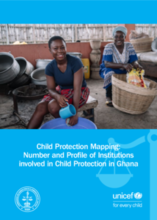This report captures the findings of a mapping exercise commissioned by UNICEF Ghana and undertaken by the Commission on Human Rights and Administrative Justice (CHRAJ). This mapping exercise sought primarily to establish the number and profile of institutions at national and sub-national levels involved in child protection. The mapping report documents identifiable Government Institutions, International Non-Governmental Organizations (INGOs), Local Non-Governmental Organizations (LNGOs), Faith-Based and Community- Based Organizations engaged in child protection work from preventive, responsive and rehabilitative perspectives. This exercise did not include an analysis of how the general child protection system functions at different levels as this was already assessed in the 2010 Child Protection System Mapping and Analysis report. The relevance of this mapping exercise is to contribute to advocacy and dialogue about more efficient strategic investment and engagement in child protection work in Ghana.
In all, the mapping found 1287 child protection institutions working in various metropolitan, municipal and districts in the child protection field nationwide. Government institutions constituted the majority and community-based organizations comprised the least. Regionally, Ashanti recorded the highest number of institutions whereas Upper West recorded the least. Government institutions had the highest number of operational offices nationwide with Department of Social Welfare (DSW) topping the list. World Vision International (WVI) recorded the highest number of operational offices among INGOs in Ghana.
The staff strength of institutions was recorded based on regional distribution, nationality, type of employment as well as gender distribution. The total number of employees the exercise identified was 69,484 out of which 36,894(53.1%) were males and 32,588(46.9%) were females. Again, 69,074(99.4%) were Ghanaians and 410(0.6%) were foreign workers. Full time employees were 58,830(84.7%) whereas volunteers were 10,654(15.3%).
Institutions worked in various thematic areas such as domestic adoption, children in residential care, trafficked children, child labour, etc. They also carried out various activities such as rehabilitation and education, family integration and maintenance, enforcement and justice administration among others. A key observation was that majority of institutions indicated that they operated in the area of ‘prevention’ as compared to areas pertaining to ‘response’ and ‘rehabilitation’. Generally, responses did not depict a clear understanding of the concepts ‘prevention’, ‘response’ and ‘rehabilitation’. Consequently, there were several similarities in respect of the responses.

